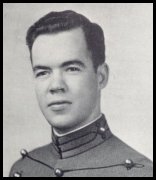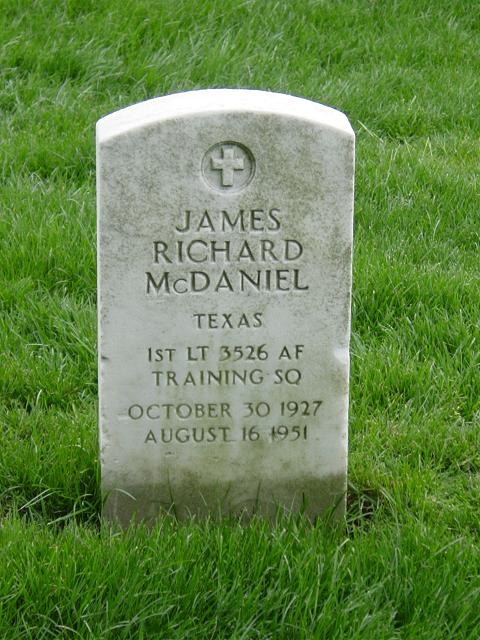Courtesy of the United States Military Academy
16810
JAMES RICHARD MCDANIEL
30 May 1927-16 August 1951
Died at Williams Air Force Base, Arizona
Interred in Arlington National Cemetery
James Richard McDaniel was born in Tientsin, China, in 1927, into a military family, a circumstance that would establish the pattern of his life until his tragic and untimely death 24 years later while serving his country. He had one older brother, Robert Lee McDaniel ’45. Known as “Dick” by his family and friends, he was greatly influenced by the environment of the Army posts his family experienced during his formative years.
From China, Dicks father was transferred to Fort Lewis, Washington, as aide-de-camp to Major General Castner, then commanding general of the 2d Infantry Division. His dad was then transferred to Fort Sill, Oklahoma, where Dick’s love of birds and wildlife was developed and where he displayed a great intellectual potential that was confirmed during his life.
From Fort Sill, the family moved to Fort Hoyle, Maryland, a small and delightful post located on the Gunpowder River that flowed into the Chesapeake Bay. At Fort Hoyle, Dick spent many hours on the water, enjoying the family’s 18-foot sailboat, a comfortable craft fortuitously equipped with an adequate “get home” outboard motor. Fort Hoyle was the home of the 6th Field Artillery Regiment, proudly the last horse-drawn regiment in the Army. Life revolved around daily polo games, Sunday hunts chasing the elusive fox, horse shows and, of course, fishing, sailing, duck and goose hunting, as well as crabbing. He developed into a superb horseman, enabling him to become a mule rider during his years as a cadet.
After three delightful years at Fort Hoyle with World War II approaching, the family was transferred to Fort Knox, Kentucky, where Dick’s dad was assigned to the 5th Infantry Division just being activated. The division was transferred to Fort Custer, Michigan, a temporary post near Battlecreek established to support the build up. Dick and the family lived in Battlecreek for a little more than a year when, in September 1941, President Roosevelt ordered the division to Iceland. Their mission was to prevent the Germans, who had recently occupied Denmark, from occupying Iceland and interdicting convoys transporting vital supplies to the UK and Russia. Dick and his mother moved to San Antonio, Texas, accompanied by the family beagle “Bingo.” His brother already was away at college.
Dick spent the years of World War II in San Antonio with his mother while his father was overseas in Europe and his brother was at West Point. In San Antonio, he attended Alamo Heights High School and grew up there with many other “Army brats” like Don Gower, who also became one of his West Point classmates. Don and Dick became good friends, hunting together and taking dates to the same local parties. Dick graduated from high school with honors and, along with Don, attended Sullivan’s Preparatory School before entering West Point in 1945 on a Presidential appointment as a member of the Class o f ’49.
At West Point, Dick excelled in his studies, consistently standing in the top ten percent of his class. He shared cadet life with his roommate, Bill Norden, with whom he established a close relationship. He was active in several student activities, including swimming, soccer, and skeet. Most notably, though, he was a cadet mule rider, appearing prominently at Army football games. He shared his academic skills with others, spending many hours coaching cadets having difficulty with the rigorous academic regimen. He graduated in June 1949 with a class standing of 38 out of 574. After graduation, he was commissioned in the U.S. Air Force.
During graduation leave, Dick traveled to Athens, Greece, to visit his parents. His father was serving with Lieutenant General Van Fleet on the U.S. Army Advisory Group to Greece. In July, he reported to Randolph Air Force Base in San Antonio, Texas, for pilot training, an event that was like going home for him, as he had spent all the World War II years in San Antonio with his mother while his father was serving overseas. As had been the custom for “Army brats” as a youth, the Officers’ Club pool at Fort Sam Houston again became his weekend hangout. He met Shirleigh Warner, the girl who would become his wife, at that pool. She was to be a freshman at Incarnate Word College in the fall and was living with her aunt, an Army widow. She too had become a constant habitue of the Fort Sam pool. The two began dating, and by the time Dick completed basic flight training and left for Nellis Air Force Base, Las Vegas, Nevada, for further training, they were committed to getting married when he was to return, scheduled for July 1950. Because the Korean War broke out shortly before his graduation, there was a question of when the wedding should take place. As soon as he found out he would not be going immediately to Korea, as many of his classmates were, the wedding date was set for 14 August 1950, allowing the bride only a couple of weeks to pull the wedding plans together.
Those were hectic and traumatic days for many in the Classes of ’49 and ’50. There were high casualty rates in both classes, as they were shipped off to war with very little, or no, advanced training after graduation. Dick’s first assignment after receiving his wings was to the training command at Connally Air Force Base, Waco, Texas. As Dick began his brief career, he and Shirleigh set up their house in Waco. After only a couple of weeks, he was to report to Craig Air Force Base in Selma, Alabama, for a three-month pilot instructor training program, after which he was to return to Connally.
In July 1951, he received orders to report on 1 Aug 1951 to Williams Air Force Base, Arizona, for jet upgrading. It was there, while flying alone in an F-80 on 16 August 1951, that he apparently experienced oxygen failure. After blacking out, he crashed in the desert in New Mexico, killing him only two weeks into his jet training and only two days after his and Shirleigh’s first wedding anniversary. Dick is interred in Arlington National Cemetery in a family gravesite arranged by his father.
Michael Robert Patterson was born in Arlington and is the son of a former officer of the US Army. So it was no wonder that sooner or later his interests drew him to American history and especially to American military history. Many of his articles can be found on renowned portals like the New York Times, Washingtonpost or Wikipedia.
Reviewed by: Michael Howard


